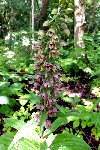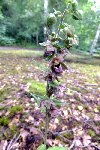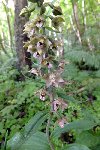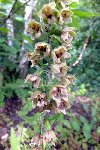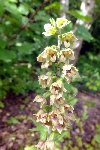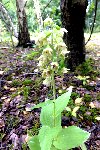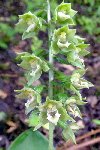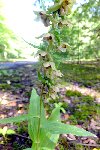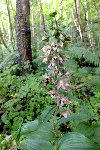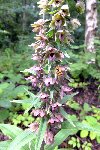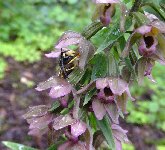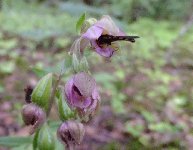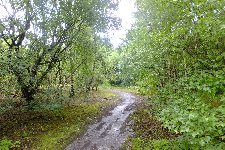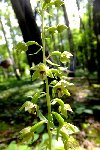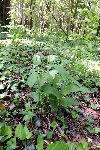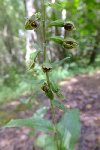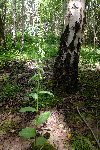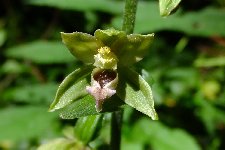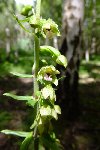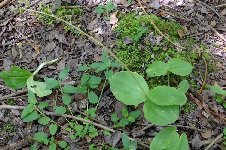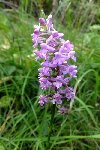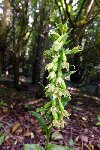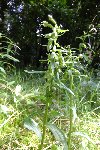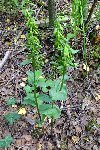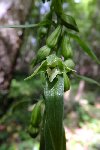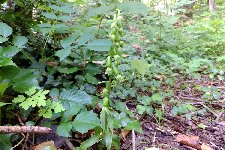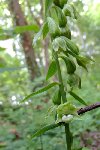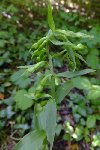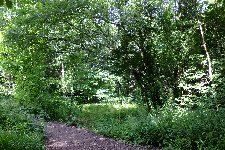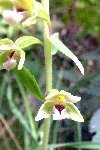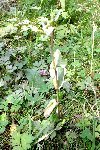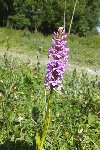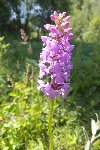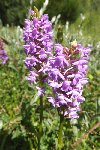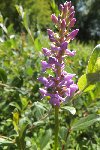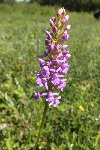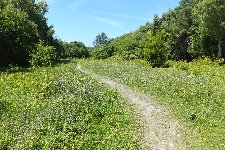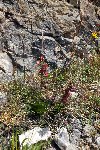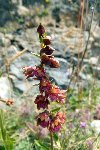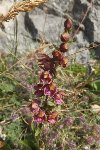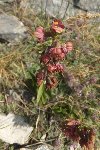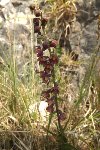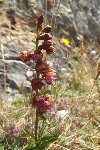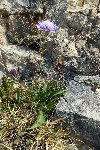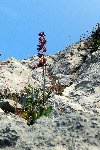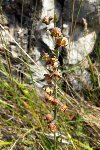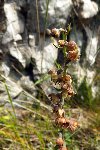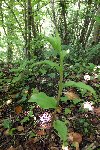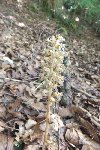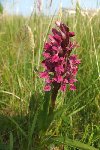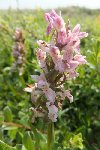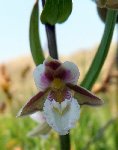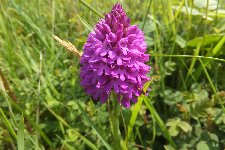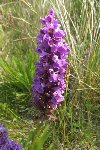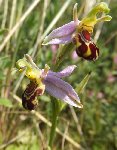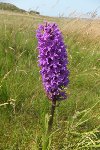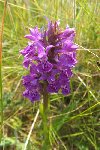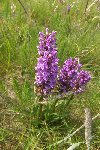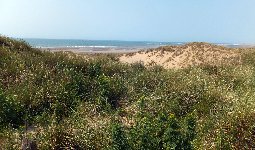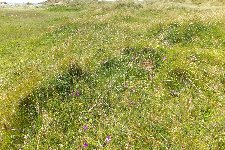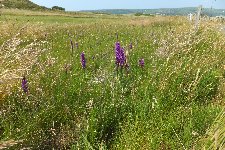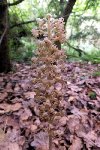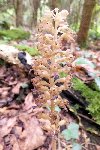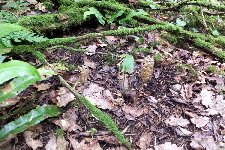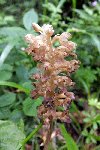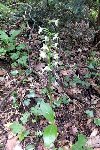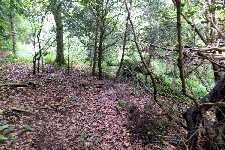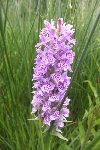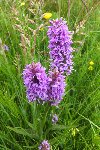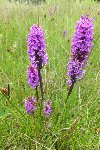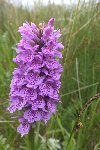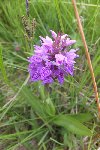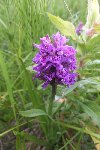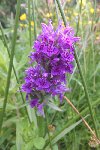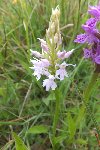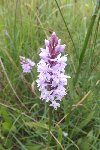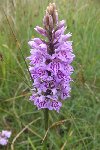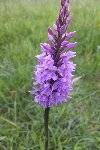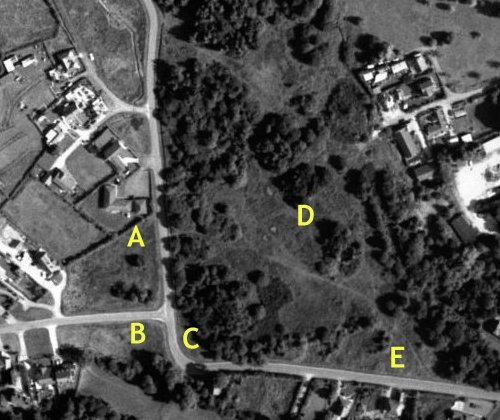|
|
|||||||||
|
|
|||||||||
 |
|
Marford woodland, Wrexham, 28th July 2013 Having got a tip off we visit a Broad-leaved Helleborine site just a few miles from home. It is new woodland (20th century) but the orchids have colonised where subsequent clearance has taken place and they seem to prefer the east facing woodland edges. I am very impressed by the spectrum of colour across the colony, from quite dark purple forms to almost creamy white. There is also one or two plants that may be E. h. viridflora, which is rare and was seen here in 2012. This variety lacks any anthocyanins and thus any pink or red colouration - my specimen does not quite hit this target. Quite a number of insects find the plants attractive. I manage to photograph some visited by ants, hover fly, gnat and a wasp. This is a site that deserves another visit next year.
Alyn Waters Country Park, 17-27th July 2013 Perhaps best to keep these multiple visits together as the latest visit was a followup to the first. That first was an organised trip around the Llay side of the park with the ranger. However the date just didn't work out well. It is a bit too late for the Bee Orchids with a few exceptions, and the Common Spotteds are generally past their best. The Common Twayblades are all out though including a three-leaf variety, but the Dune Helleborines and the Green Flowered Helleborines are still in bud due to the poor Spring we had, or so everybody says. Regardless we tramped around and came upon a pair of Marsh Fragrant Orchids alongside the northernmost path. More importantly I find out where the D. fuchssi var rhodchila flowered in 2012; no sign of it this year but that's one for 2014! Though an organised walk can be a bit restrictive, you at least find out what there is to be seen, no more no less. And apparently you can find out the the same species do occur on the Gwersyllt side, but in lesser numbers. The follow-ups find the Dune Helleborines flowering nicely, though some growing more in full sun do not seem to be opening fully, but those growing under the trees are impressive. There seems to be no Broad-leaved Helleborines, or at least no full blooded ones, even though there should be a minor population growing here. The are some specimens that do have BLH features such as deeper green leaves and ovaries that twist around. But they are self-pollinating; they lack the viscidium and the pollen is crumbling into the cup. This seems to over-rule BLH, and class them as Dune Helleborines. This does not rule out the possibility of hybridisation between the two species. They have been here long enough, over 20 years, and in sufficient numbers to make this a possibility. Could it be the Broadleaved have been largely replaced by hybrids?
Marford Quarry, 27th August 2013 Last year we found two sites each with about 6 flower spikes of the Green Flowered Helleborine, but this year there is only one in total. A further hunt finds a single, presumed, Broad-leaved Helleborine, as we continue the search. We are about to leave I notice an area between the two sites which looks promising. We find about 12 flowering spikes of the GFH. Unfortunately none of these have open flowers, unlike last year.
Delamere Forest, Cheshire, 22nd July 2013 Nothing too much to report here. Did a 5 mile trek through both the pine and deciduous trees, and finally found a small group of three Broad-leaved Helleborines, along the path that runs along the northern side of Blakemere. They were all a bit on the small side and one had variegated leaves. I am guessing its either nutrient deficiency or the weather factor. But it has been pointed out that this resembles a Dune Helleborine
Anderton Country Park, Northwich, 14th July 2013 I had hoped that using information in Harrap that this entry would be headed Witton Lime Beds. These are the dumps where soda ash from the chemical industry nearby was discarded. We park up on the outskirts of the town and head for the Carey Park entrance. One path leads to the left of the beds but there is no way through the trees. So the other path is the one to take. And there they are marked out with notices declaring No Public Access and Survey Staff Only. I look over the fence but cannot see any obvious candidates for the (1,000s) Marsh Fragrant Orchids said to grow here. A big disappointment, but a trip here in 2008 revealed these orchids growing elsewhere. Off we go trying to retrace steps from 5 years ago and find we've walked right across to the Anderton Boat Lift. A chance for an icecream before setting off back by different paths. Eventually I spot the orchid site, identified by the gate at the entrance to the field. Addendum: Apparently the place to go is the bit between Neumann's Flash and Ashton Flash, by the bird hide. Close by are some Marsh Helleborines too. We were actually only 300 yards from that hide on the way back to the car. One for another year.
We've been to the Orme many times, and have looked in vain for the Dark Red Helleborine. According the books, especially Wild Orchids in Wales by Sue Parker, it grows in the grykes in the limestone pavement. This geological feature, on Great Orme, is in scattered patches above Marine Drive at the far end of the rock. Several searches there have been void of any orchids, including examination of one 40 foot square patch that is caged presumably to protect plants from rabbit grazing. A diversion of the way home to Little Orme. 27C and not a cloud in the sky, and barely any shade. And barely any evidence of orchids. We find one Pyramidal Orchid and a fruiting Early Purple Orchid. A notice board announces that Dark Red Helleborines grow here too. During the journey along the A55 I spotted two groups of Common Spotted Orchids on road verges. One was at the top of Rhuallt Hill and the other was in the centre of the dual carriageway at Llandulas. I didn't bother stopping to confirm them! Nant Alyn, Rhydymwyn, 8th July 2013 Just a short walk along the River Alyn, or at least the bed of the River Alyn as it's dried up again, or rather gone subterranean and refilling the natural aquifers. Further upstream at Loggerheads the river disappears underground in the limestone of the area. The south bank is old woodland but with steep slopes and the only paths run parallel to the course of the river. The first discoveries were some Green Flowered Helleborine. These are not in flower yet and mainly just solitary plants. But they are previously recorded from the area. Whether this is var pendula remains to be seen, but other local examples have been of this variety. And we find a single Birds Nest Orchid, the second sighting of these elusive orchids in week! This is near a public footpath, but unfortunately the woodland is on quite a slope and the footpaths run sort of parallel to the river. There may be other examples and more discoveries to be made here if I ever return.
Following the failure to locate the Lesser Twayblade we double back, and head off to Ynys Las where at least some orchids will be seen. We are a bit later visiting than other years, but 2013's catch phrase is "Everything is a couple of weeks late this year". Early Purple ssp coccinea and incarnata Marsh Helleborine Pyramidal Southern Marsh Bee Orchid Northern Marsh `Western Marsh' `Welsh Marsh' Dunes view The seaward dune slack The roadside site Hirnant Valley, Mid Wales, 5th July 2013 The Lesser Twayblade is one of those orchids you are extremely unlikely to make a chance discover of. It isn't common, grows on the mountains off track that are beaten and unbeaten, and has small flower spikes. So having directions to where it goes we make a detour involving 7 miles of unfenced single track road between Lakes Vyrnwy and Bala to 1626 foot above sea level. Then spend an hour examining an acre of quite damp moorland looking in and under the old heather heather for even one example. No such luck. Another year perhaps? Coed Cilygroeslwyd, Ruthin. 1st July 2013 Before the trip to Le Mans we had been to Royden Park on the Wirral. There is a well tended walled garden there, a third of which is wooded. A notice proclaimed the existence of the Birds Nest Orchid there. Well, an intensive search in what is quite a small area revealed nothing. Feeling a bit cheated by this I did some research and found this location as a potential site. However the recorded area covered both sides of the A494, and of course we went the wrong side first - down the old Corwen to Ruthin railway trackbed, which is impressive in its own way. We then crossed over the road and took the footpath leading uphill in the woods opposite. Scattered beside the path, and through the woods, in single plants and pairs were some nice Greater Butterfly Orchids. At a clearing just before entering the reserve proper is a colony of Common Spotteds. A notice board proclaims Coed Cilygroeslwyd to be ancient woodland; ideal for our search. We take the left hand route for a while then turn up another path to rejoin the path through the middle. Just beyond this, in the shade of a big yew we find a group, perhaps 8 or so, of Birds Nest Orchids. They are not too difficult to spot actually and do seem to stand out from the leaf litter. Another first for 2013! Taking the path back we even find more growing in what is a not particularly shady spot and poking out from other vegetation. Not a text book site. This wood must contain quite a few groupings of this elusive orchid. Four views of the Birds Nest Orchids and one of the Butterflies Nearby is Craig Adwy, a smallish limestone hill, topped by an ancient fort, and allegedly a famed butterfly site. Do we see a single butterfly? No. True it wasn't sunny or particularly warm, but it did seem that was rabbit cropped hilltop with thyme and vetch a few years ago was now all bracken. Still we did see more Greater Butterfly Orchids and (after flowering) Early Purple Orchids.
A stop off here, en-route to other orchid sites, just to see how they are doing. It doesn't seem like its been three years since I was last at this site. The orchids have put on a good show as usual, though first impression is that there was quite as many this year. The verges have had a mow some time ago but the rest seems to have longer grass. The common itself seems to have had a number of vehicles driven over it from the number of ruts; probably last year or 2011. A selection of the x venusta hbrids Some of the typical Common Spotteds
An aerial view of the Common and surrounding area indicating the main orchid areas. A is mainly longer grass. Here were Common Spotteds and Hybrids. B is a damper area with thinner grass. Again both types are present together with some closer to typical purpurella. C is a roadside verge where Common Spotteds outnumber the hybrids. D is the main part of the Common. All three grow in the central area. E is open common adjoining the road where Common Spotteds predominate.
A483 Wrexham Between the Rossett and Gresford junctions on this road, going uphill southwards about this time of year you can spot a colony of Common Spotted Orchids on the verge. I noticed these first in 2011 when they put on quite a display. That is, until the contractor employed by Wrexham council dutifully mowed them in in full flower. The were still there 2012 but this year they seem reduced in number; even driving by slower than normal they are harder to spot. I hope the mower leaves them alone until at least seed is set this year.
|
|
|
||||||||||||||||||||
